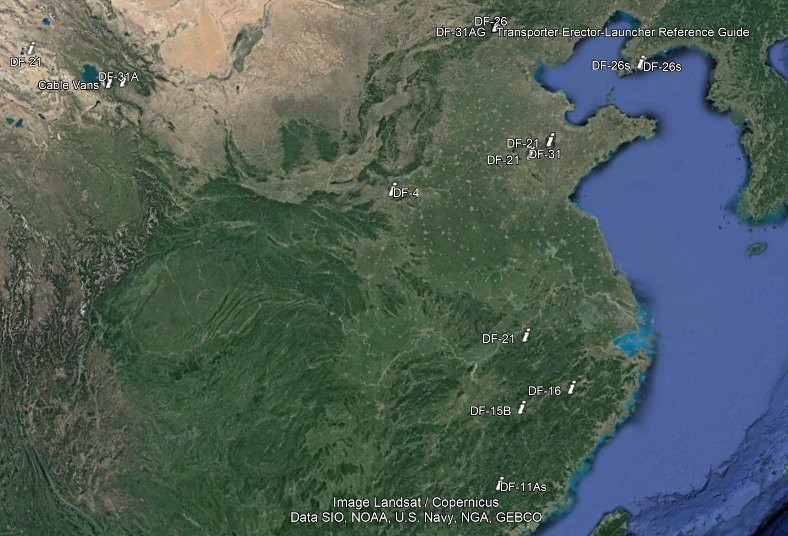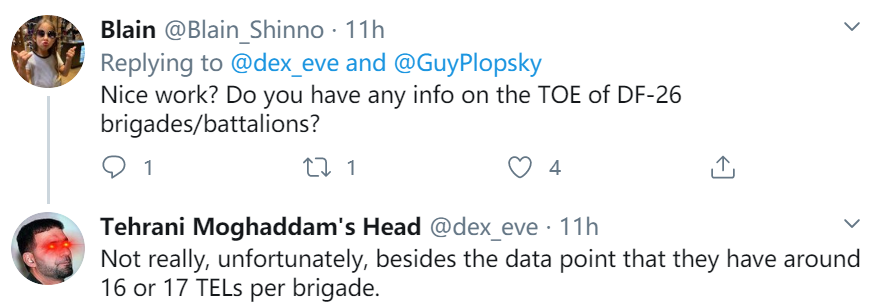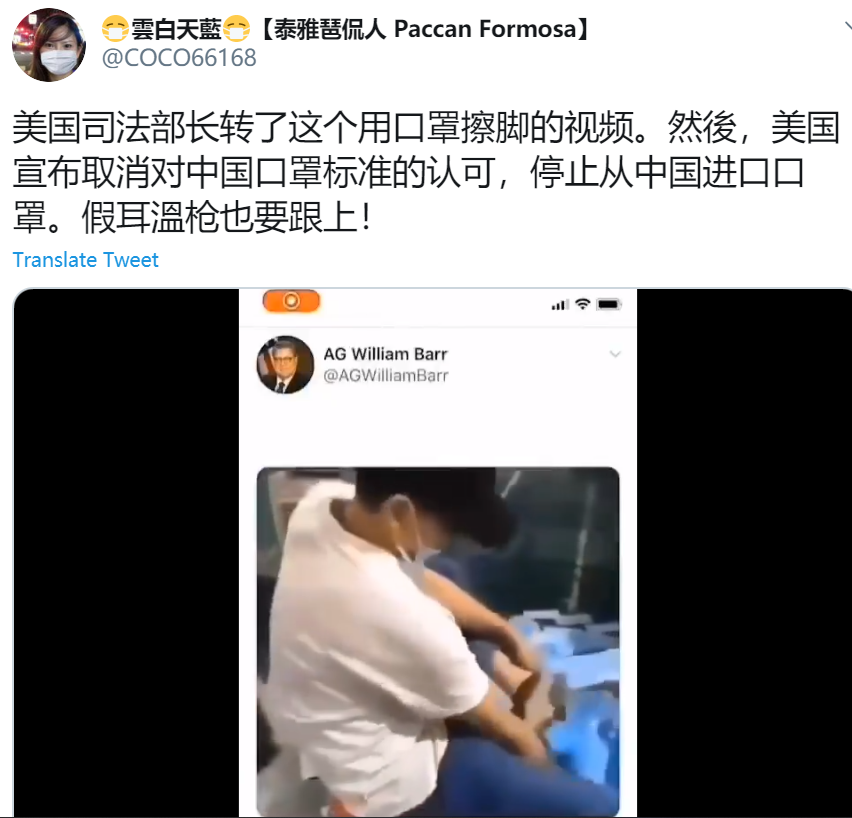



Mapping the People's Liberation Army Rocket Force by Decker Eveleth Introduction The People’s Republic of China processes one of the largest missile forces in the world. Ten years ago the number of Chinese missile brigades numbered around twenty to twenty-five. Today the number is closer to forty brigades, with ten of those brigades being added in the past three years. In addition to a growing force of ICBMs, the PRC also processes large numbers of accurate and nuclear capable medium and intermediate-range missiles. These forces are organized into the People’s Liberation Army Rocket Force (PLARF), one of China’s five service branches. The recent reorganization of the Rocket Force and the proliferation of brigades has warranted a reexamination of its order of battle, which has grown in both numbers and capability. Part of the reason why China’s missile forces are so large is that unlike the United States and Russia, China was never bound by the terms of the recently deceased Intermediate-Range Forces Treaty (INF) Treaty, which banned missiles with ranges between 500 kilometers and 5,500 kilometers. Without such arms control in place, the PRC was free to develop a wide array of short and medium-range systems. The United States has no system equivalent to missiles like the DF-26 IRBM, which has a range of 4,000 kilometers. The last time someone attempted to compile a complete picture of China’s ballistic missile forces was over a decade ago with Sean O’Connor’s report on the Second Artillery. Because no one has released an updated dataset, scholars have had to rely on decade old orders of battle when examining the PRC military. I’m making this dataset publicly available so that more information on China's force posture is easily accessibly. I have put together an as complete as possible picture of the PLARF’s order of battle entirely with data publicly available online. The majority of my own conclusions on brigade equipment come from detail matching ground imagery released by Chinese state media or collected from Chinese social media sites like Weibo. In addition, 1980s era declassified documents from the Central Intelligence Agency yielded a surprising amount of data on active ICBM brigades. Organization The People’s Republic of China formed the Second Artillery Corps in 1966, the precursor to the modern day PLARF. Initially, this force deployed only small numbers of nuclear-capable medium-range ballistic missiles (MRBM) and intermediate-range ballistic missiles (IRBM). Over the years this force has grown with the addition of siloed intercontinental ballistic missiles (ICBM) in 1981 and then the introduction of the DF-21, the PRC’s first truly mobile missile system, in the late 1980s. Instead of deployed units reporting to regional military commands like regular People’s Liberation Army Ground Forces units do, the Second Artillery Corps reported directly to the Central Military Commission, the civilian Communist Party organization that oversees the military. In 2015 the Second Artillery Corps was reorganized into the People’s Liberation Army Rocket Force, now a full branch of the PRC’s armed forces. This was immediately followed by massive increase in the number of deployed brigades, constituting a 25-30% increase in the total number of missile brigades in the PLARF. This force is organized into seven bases, which are all concentrated in certain regions. Previously, these bases were numbered 51 through 56, with Base 22 being the warhead storage and handling base. Brigades were numbered in the 800s. After the reorganization in 2015, the bases were renumbered bases 61 through 67, with Base 67 being the new designation of Base 22. Brigades were also renumbered to match their base. For example, a brigade under Base 62 will have the designation Brigade 62X. Each base supervises around six brigades. Each brigade encompasses thousands of personnel, with the missile launchers themselves being divided into launch battalions formed of launch companies. The number of transporter-erector-launchers (TEL) per formation varies greatly depending on what kind of missile the brigade is equipped with. For example, DF-31 brigades are though to have around twelve launchers per brigade, with each company being responsible for a single launcher, while DF-15 brigades have as many of thirty-six launchers per brigade and each company having up to three launchers. Cruise missile brigades are thought to have twenty-seven TELs, and IRBM brigades are thought to have around sixteen. Anatomy of a Brigade Base Chinese missile brigade garrison are usually built to an easy to identify standard that I will outline, although the standard does seem to change dependent on time period. Most bases are large, square facilities with a clear security perimeter. An administration building, or multiple administration buildings, are near the center of the complex, most of the time facing the main gate. On either side of administration are rows of housing for the brigade. This layout is shared with most other PLA garrisons. The real signature of a missile base is the high bay garage and launcher garages usually near the back of the base. The high bay garage is a usually around twenty or thirty-foot-tall structure used to erect missiles indoors and out of sight of satellite images. Nearby will be garages for the missile launchers and support vehicles. Sometimes these garages are aligned in rows, and sometimes in a doughnut pattern, like the ones in Yuxi (622) missile. In some cases, the launcher garages are attached to the high bay, like the ones at Jianshui (625) or Laiwu (653).   Xinyang, Brigade 666, is a fairly typical example of a PLARF brigade level facility. A single main gate faces an admin building flanked by barracks buildings. Support vehicle garages, military communications, and a weather telemetry station are also present. The high bay is an example of one with attached launcher garages. We can match the layout of this high bay, including its window and skylight pattern, to imagery released on CCTV, confirming its status as a DF-26 brigade:   Order of Battle Below is the current order of battle for the PLARF. There are a total of 39 brigades, but another brigade, 618, might also have been recently commissioned. Some bases have certain roles that match the missiles they are equipped with. For example, Base 61, directly opposite Taiwan, is equipped with almost the entirety of the PLARF’s short range ballistic missile inventory. Others, like bases 62 and 63, have much more diverse missile inventories.   The PRC designates their missiles in numbered classes that are somewhat indicative of their range class. Missiles in the single digits are the older 1970s and 80s era ballistic missiles. The DF-4 might still be in service at Sundian (662) or Tongdao (634), while the DF-5 is most definitely still in service with some being upgraded to the DF-5C. The DF-1X class constitutes short-range ballistic missiles (SRBM) and cruise missiles (LACM), with ranges below 1,000 kilometers for ballistic missiles, and around 2,000 kilometers for cruise missiles. The DF-2X class encompasses both the DF-21 medium-range missile and the DF-26 intermediate-range missile. The DF-3X and DF-4X class each only have one missile system, the DF-31 and DF-41 respectively. The DF-31 is a mobile intercontinental ballistic missile that originally had a range of only 7,200 kilometers before being upgraded to the DF-31A, which has a range of 11,200 kilometers. This system is currently being upgraded with an improved TEL design, the DF-31AG. The DF-41 is the PLARF’s newest mobile ICBM, which could have a range up to 15,000 kilometers. The basing for the DF-41 is currently unknown, but Hanzhong (644) has been noted as a candidate. Some recent notable expansions to the force include the deployment of three (or possibly four) DF-26 IRBM brigades and the upgrades to Brigades 617 and 636, which are now armed with the DF-16 SRBM. We should expect to see more DF-26 brigades in the future. Recent satellite imagery of TEL production sites show that they are still being produced in large numbers. In the realm of intercontinental ballistic missiles, DF-31A brigades continue to be upgraded to the new DF-31AG TEL. It is worth noting that we have seen upgrades, but not a significant expansion of the total force of DF-31A missiles. The DF-5 silo force remains in service, with the new DF-5C mod missile having gone into production quite recently. A silo basing option for the DF-41 ICBM is reportedly being considered alongside their mobile role. These missiles may be based in Jilantai in Inner Mongolia or at Sundian (662) in Henan Providence. Remaining Questions There are several directions the PLARF could take their ICBM force. Tai’an Special Vehicle continues to produce the DF-31AG TEL, but whether these TELs are for upgrading existing brigades or are for the creation of new brigades us unknown. We already have evidence that the newly formed Brigade 664 has been armed with the DF-31AG, which might mean that the other new brigades in the area will be equipped with that system. It’s also possible that some of these new brigades will be equipped with the DF-41. DF-26s have been showing up at many locations associated with the DF-21, which has thrown a lot of the older data on DF-21 deployments into question. CCTV’s habit of splicing together DF-26 footage with DF-21 footage has further muddled how the PRC’s medium-range forces will grow. The rapid growth of the DF-26 also makes it difficult to determine where the DF-21D, the PLARF’s anti-ship DF-21 variant, has actually been deployed. Recent estimates of DF-21D force strength suggests that they have fifty TELs, which translates into two brigades. We have ground imagery of the DF-21D at Laiwu (653). Qingyuan (624) might also be a DF-21D base, but Qingyuan actually currently hosts two brigades, and the ground imagery has at least one of those brigades as a DF-26 unit. The PLARF will probably continue to expand its arsenal of DF-16 SRBMs, probably by replacing some of their remaining DF-11A brigades. Recent imagery out of base 61’s training garrison shows a DF-11A unit with DF-16s present as well. Where the PLARF will put their new short range hypersonic, the DF-17 is currently unknown, but Danzhou is a possible candidate. The People’s Liberation Army Rocket Force has undergone a massive expansion in recent years, adding ten or more brigades in the last three years and three new systems in the last four. Recent imagery has gone a long way in clearing up questions about the order of battle, but at the same time has produced many more. Hopefully the release of further imagery will clear up many of these questions. I will continually update this KMZ as I dig up information and further information comes to light. In the future I will also write up the PRC’s missile and TEL production facilities as a separate blog post and KMZ. Works Cited in the Production of This Report: “Chinese Missile Encyclopedia Section II: Missile and Missile Equipment Storage and Handling Facilities.” Central Intelligence Agency. https://www.cia.gov/library/readingroom/docs/CIA-RDP84T00171R000301550001-8.pdf Bhat, Vinayak. "China media reports a new missile brigade that can hit Mumbai. What’s really new about it?" The Print, April 19th 2019. https://theprint.in/defence/china-media-reports-new-missile-brigade-hit-mumbai/50731/ Bhat, Vinayak. “China’s new, secret missile garrison in Sichuan can target all of india and beyond.” The Print, June 27 2018. https://theprint.in/defence/chinas-new-secret-missile-garrison-in-sichuan-can-target-all-of-india-and-beyond/75347/ Boyd, Henry. “2019 Pentagon Report: China’s Rocket Force Trajectory” Military Balance Blog, International Institute of Strategic Studies, May 15th 2019. https://www.iiss.org/blogs/military-balance/2019/05/pla-rocket-force-trajectory Kristensen, Hans M. and Korda, Matt. Chinese nuclear forces, 2019, Bulletin of the Atomic Scientists, 75:4, 171-178, DOI: 10.1080/00963402.2019.1628511 Kristensen, Hans M. “China’s New DF-26 Missile Shows Up At Base in Eastern China.” Federation of American Scientists, January 21st 2020. https://fas.org/blogs/security/2019/09/china-silo-df41/ Kristensen, Hans M. “New Missile Silo and DF-41 Launchers Seen in Chinese Nuclear Missile Training Area.” Federation of American Scientists, September 3rd 2019. https://fas.org/blogs/security/2019/09/china-silo-df41/ Lafoy, Scott and Eveleth, Decker. “Possible ICBM Modernization Underway at Sundian.” Arms Control Wonk, February 5th 2019. https://www.armscontrolwonk.com/archive/1208828/possible-icbm-modernization-underway-at-sundian/ Singer, Peter W. and Xiu, Ma. "China’s Missile Force is Growing at an Unprecedented Rate", Popular Science, Febuary 25th 2020. https://www.popsci.com/story/blog-eastern-arsenal/china-missile-force-growing/ Stokes, Mark A. “China’s Future Nuclear Force Infrastructure”, PowerPoint presented at the East Asian Alternative Nuclear Weapons Futures Workshop at Stanford University, November 2013. http://www.npolicy.org/article_file/Nov2013-Stokes.pdf
Logan, David C. “Making Sense of China’s Missile Forces.” In Chairman Xi Remakes the PLA: Assessing Chinese Military Reforms. National Defense University Press, 2019. https://ndupress.ndu.edu/Portals/68/Documents/Books/Chairman-Xi/Chairman-Xi.pdf
Logan, David C. Career Paths in the PLA Rocket Force: What They Tell Us, Asian Security, 2019, 15:2, 103-121, DOI: 10.1080/14799855.2017.1422089
O’Connor, Sean, “PLA Second Artillery Corps”, Air Power Australia, 2009. Last updated 2011. https://www.ausairpower.net/APA-PLA-Second-Artillery-Corps.html Stokes, Mark. "China's Nuclear Warhead Storage and Handling System", Project 2049, 2010. https://project2049.net/wp-content/uploads/2018/05/chinas_nuclear_warhead_storage_and_handling_system.pdf Stokes, Mark. “Second Artillery Anti-Ship Ballistic Missile Brigade Facilities Under Construction in Guangdong?” Project 2049, 2010. https://project2049.net/2010/08/03/second-artillery-anti-ship-ballistic-missile-brigade-facilities-under-construction-in-guangdong/ 




















|
